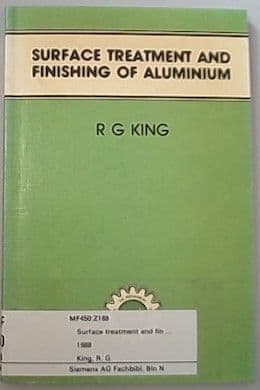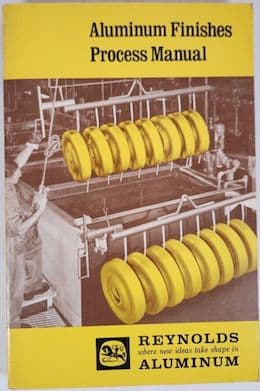
Curated with aloha by
Ted Mooney, P.E. RET

The authoritative public forum
for Metal Finishing 1989-2025

-----
Anodizing: Need Complete Procedure
for Shops, Specifiers & Engineers

avail from eBay, AbeBooks, or Amazon

avail from eBay, AbeBooks, or Amazon

avail from eBay, AbeBooks, or Amazon

avail from eBay, AbeBooks, or Amazon

avail from eBay, AbeBooks or Amazon
(as an Amazon Associate & eBay Partner, we earn from qualifying purchases)
Q. Sir we are the manufacturers of aluminium canisters which are used for packing pharmaceutical but the problem is that when we anodize the canister for 40 mins then the colour of the canister turns to dark grey and when we do it for 15 mins then the spot comes we need 6 - 12 microns on the canisters and we want matte finish and bright silver colour could you please assist me which chemicals that we should use and at which percentage and at what temperature.
I would be very grateful to you if you please explain me the complete procedure from the scratch with all the details. Your prompt reply will be appreciated. Anxiously waiting for your reply.
Thanks/Best regards,
Gaurav Verma- India
2001
A. Hi Gaurav. The matte finish you desire probably comes from an etching step after the cleaning step and before the desmutting step -- not from conditions in the anodizing tank itself. The bright silver may be a dyeing step or you may want electropolishing or bright dipping of the aluminum.
We can probably help with specific questions, but only books can offer you "the complete procedure from scratch with all the details" because that fills hundreds of pages. Anodizing consultants are available as well.
Good luck!

Ted Mooney, P.E.
Striving to live Aloha
finishing.com - Pine Beach, New Jersey
Q. We are into the field of manufacturing all types of furnaces and silicon carbide heating elements. We have a plan to diversify into other business. As we are not having much experience in the field of anodizing, could you please help us in detail?
Nagaraj G- Bangalore, Karnataka, India
2002
A. Hi cousin Nagaraj.
Briefly it's a process to apply a hard, corrosion resistant, sometimes dyed, finish on aluminum. It usually involves alkaline cleaning, etching, desmutting, the anodizing step per se, optional dyeing, and sealing.
The anodizing step itself involves making the aluminum anodic, via a power supply, in a solution of sulfuric acid.
But I don't think that you could, in a public forum, tell others in detail how to manufacture all types of furnaces or silicon carbide heating elements, and in turn I don't think they can tell you in detail about anodizing either :-)
You might start consult one or more of the above books about anodizing.
Best of luck, and feel free to come back with your questions.

Ted Mooney, P.E.
Striving to live Aloha
finishing.com - Pine Beach, New Jersey
I am a student and I want to know what materials, etc. are needed for anodizing aluminium in a science lab.
Guy Davis- Aylesbury, Bucks, England
2003
|
A suitable type of aluminium (say 99.5% pure, or another suitable alloy) as your anode, lead sheet as the cathode, 10% sulfuric acid, a rectifier capable of delivering up to 100A/ft2 and a lot of ice to keep the electrolyte cold  Trevor Crichton R&D practical scientist Chesham, Bucks, UK Is this to be chromic or sulfuric or phosphoric anodizing? A trip to the library would help. In sulfuric acid anodizing aluminum will work as well as lead for the cathode. Your power source should go to at least 15 volts at full load. The 10% is by volume if you are using lab grade sulfuric. About 1:1 if you are using battery acid ⇦ this on eBay or Amazon [affil links] . Caution, acid to water, not vice versa and it generates a huge amount of heat. The ice is in an outer double boiler, not in the acid. 72± 2 °F for decent product, mild agitation. Seal in boiling DI water. James Watts- Navarre, Florida
(No "dead threads" here! If this page isn't currently on the Hotline your Q, A, or Comment will restore it) Q, A, or Comment on THIS thread -or- Start a NEW Thread Disclaimer: It's not possible to fully diagnose a finishing problem or the hazards of an operation via these pages. All information presented is for general reference and does not represent a professional opinion nor the policy of an author's employer. The internet is largely anonymous & unvetted; some names may be fictitious and some recommendations might be harmful. If you are seeking a product or service related to metal finishing, please check these Directories:
Finishing About/Contact - Privacy Policy - ©1995-2025 finishing.com, Pine Beach, New Jersey, USA - about "affil links" |